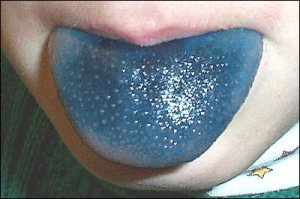
You can determine your supertaster status by painting your tongue blue, as in the last post, but there’s a simpler, less messy way. It’s not as immediate as examining your tongue in the mirror, however. You’ll need to send away for a test strip that determines your bitter taste sensitivity.
A few posts back I wrote about the 1931 discovery that some people can taste the bitter chemical PCP and some cannot. An especially strong reaction to the bitter taste of this chemical — or to PROP, a related bitter chemical — indicates you’re a supertaster.
When researchers study taste sensitivity, they prepare glasses of water with increasing concentrations of PROP. By starting with plain water and progressing to denser solutions, they determine the threshold at which you become sensitive to the bitter taste. For a simple yes/no answer to the question “Am I a supertaster?” you can simply taste a piece of paper impregnated with a strong concentration of PROP. If you notice nothing but paper, you’re a nontaster. If you’re a supertaster, you’ll want to spit it out. Medium tasters can detect the bitterness, but don’t find it revolting.
You can purchase test strips online from the Supertaster Test website. They come in packages of two, cost $4.95, and the shipping and handling was only an extra $2 for California. They ship internationally and come with a money-back guarantee. The site claims the taste test is “an indispensible tool for the health-conscious food lover.”
Read more









